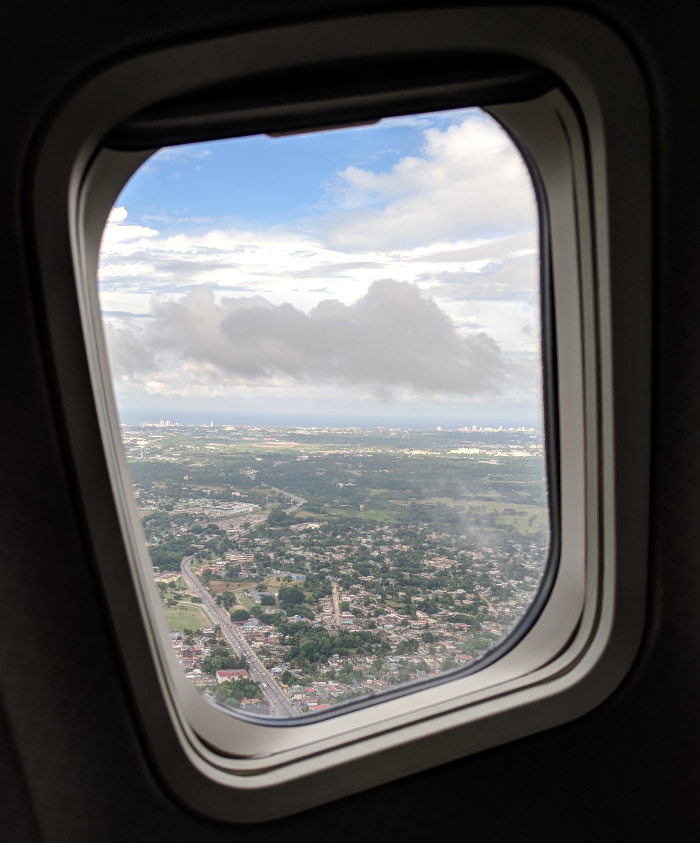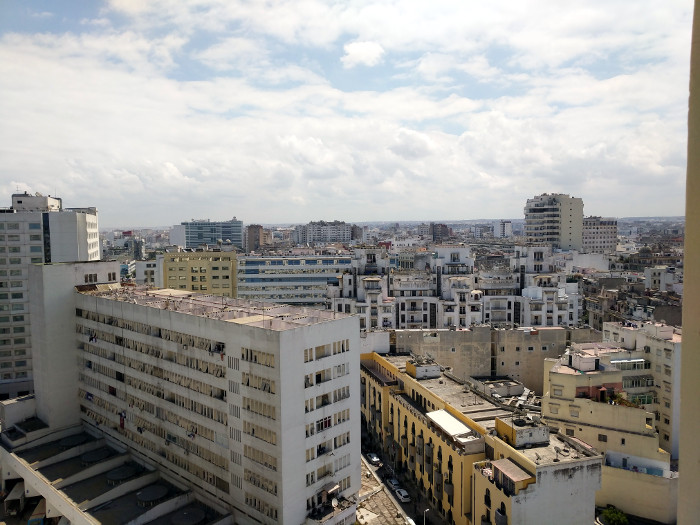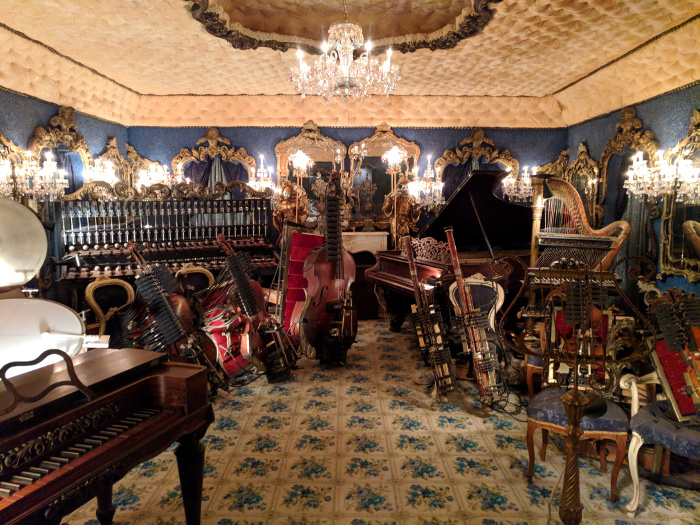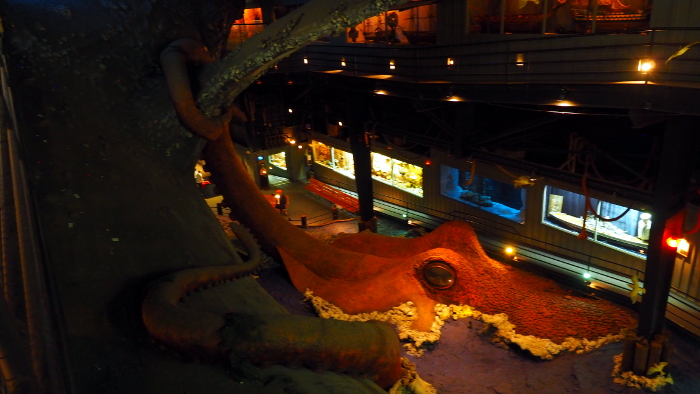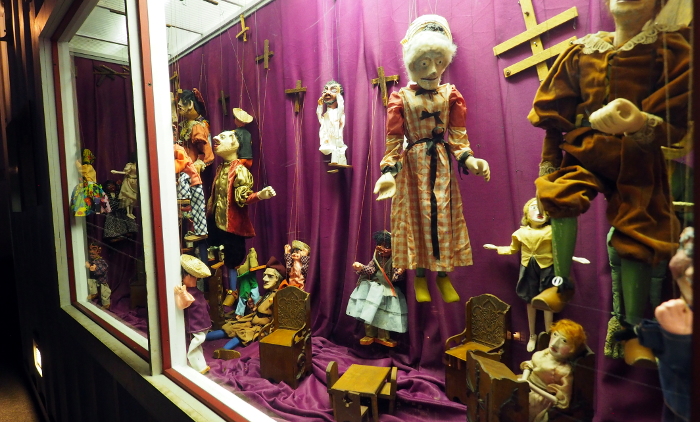There are no mobile phone zombies in Cuba. That was one of the things I noticed right away. I don’t think that Cubans have any special resistance to the lure of the Internet, it is just that Cuba is one of the least connected countries in the world. I’d have to agree, since I’ve connected from places as remote at the Night Market in Siam Reap, Cambodia, and the island of Espiritu Santo in Vanuatu, yet had a hard time getting on the Internet from Havana.
But I get ahead of myself.
Many years ago I set the goal of visiting 50 countries before I turned 50. I didn’t make it. Cuba was the 40th country I’ve been in, if you include the United States.
Even though Cuba is very close to the United States, it has always seemed a bit mysterious to me because of the embargo. I do have friends who have visited, mostly from Europe, but one American friend of mine was able to go via Mexico. He was kind of upset – he arrived the day after Fidel Castro resigned. Last year I decided I was going to visit Cuba, but I wanted to do so legally, and thus I set out to find the requirements.
It turns out that one of the allowed reasons an American can visit Cuba is for “professional meetings”. As I work in both telecommunications and with free and open source software, I started searching for a conference I could attend. I discovered CubaConf, but was disappointed to learn that the conference had already been held for 2016.
So, I kept my eye out to see if the conference was going to be held again in 2017. When they announced November dates, I submitted a paper and was happy when it was accepted. I decided to take along my friend and coworker Alejandro. He was born and raised in Venezuela and thus speaks fluent Spanish, and while my Spanish is good enough that I might have been able to get by, it was extremely handy to have Alejandro around (plus I think he enjoyed the trip as well). I had wanted to spend as much time as possible in Cuba, but I also wanted to make sure I adhered to the travel rules, and since those forbid tourism outside of a registered tour we went down on Monday and returned on Friday (the conference was Tuesday through Thursday).
Due to the embargo, American banks cannot do business in Cuba, thus credit cards don’t work. Luckily, the two most expensive parts of the trip, airfare and lodging, could be arranged and paid for in advance. American Airlines has a number of flights to Havana, and AirBnB has a large presence in Cuba due to the tradition of “casa particulares” or “private homes”. There are hotels in Cuba but many people stay in rented rooms, usually in peoples’ homes. This matched perfectly with the AirBnB service and I was able to book a wonderful, three bedroom apartment in the heart of old Havana.
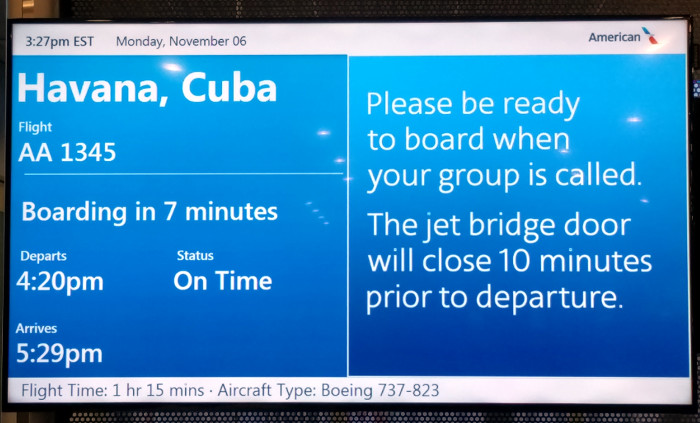
We flew from RDU to Miami, and then took the short flight to Havana. Entering the country was pretty easy. You had to have a visa, which I bought beforehand, and you needed to fill out a health card, but outside of that the longest wait was for luggage. They do perform a thorough search of luggage, looking mainly for wireless electronics and other contraband, but as I had none of that my bag arrived pretty much unmolested.
Yaima, who was renting us the apartment, had arranged for a driver, so we were met after we exited customs. While Alejandro talked with him I went to the Exchange to get Cuban Convertible Pesos, or CUCs (kooks). They map one to one with the US dollar, except they also charge an exchange fee (which doesn’t exists for euros or UK pounds). I had brought several hundred dollars in cash with me to cover expenses, and the whole process was pretty easy.
The airport is some distance outside of the city and so we got to see some of the area on our way to Old Havana. Our taxi was a later model car, I think it was a Nissan of some sort, and our driver was pretty quiet. We passed through the more modern section of Havana on our way to Havana Vieja (Old Havana) and you could tell when the buildings got older and the streets narrower.
When we arrived at the apartment building, the driver made a call and a large garage door came up. He drove in on the ground floor, which also served as the lobby, and we got out to check in to our room.
Our apartment was on the top floor, and it was very nice. It had three bedrooms. There was me and Alejandro but also my friend Elizabeth who I often see at open source conferences. She had heard about CubaConf from me and decided to attend as well, and so I offered up the last bedroom to her. There were two rooms with king-sized beds that shared a bathroom, and a smaller room next to the kitchen that Elizabeth took. On each end of the apartment was a balcony, and I spent a lot of time out on the front one enjoying the sights and sounds of Old Havana.

Outside of the conference I had another objective. I wanted to visit three famous bars in Havana: El Floridita, Hotel Ambos Mundos and the Hotel Nacional. El Floridita was pretty close to our hotel, so as soon as we dropped off our bags, the three of us made our way there.

Old Havana is easy to walk, and we felt pretty safe for most of the trip, no matter how late it was. There were several “touts” trying to get you to go into a store or a restaurant, and one that kept coming up was “La Familia”. We were told by several people in the street, in both Spanish and English, that we should eat at La Familia. It was so prevalent that we made a group decision to never eat there.
El Floridita bar is known as the birthplace of the Daiquiri. I learned about it from Ted Haigh’s seminal book Vintage Spirit’s and Forgotten Cocktails and I had always wanted to visit. This is a place made famous by Ernest Hemingway, who used to drink there, so much so that they have a bronze statue of him in the corner of the bar.

I have no idea what was going on with my hair in that picture.
The place was crowded but we managed to squeeze in right next to the statue. I wanted Hemingway’s signature drink, the Papa Doble, which is a Daiquiri with double the rum and the addition of grapefruit juice. The bartender told me, in Spanish, that due to the recent hurricane they couldn’t get toronja (grapefruit) and suggested a “Daiquiri Classico”. I figured it was the next best thing and had several (as did my companions).
I liked sitting there watching the bar. There is a sign announcing that this is “The Cradle of the Daiquiri”

and I liked watching the bartenders (cantineros) prepare drinks. While they use shakers like most bartenders around the world, there is a style unique to Cuba where they pour the drink from one iced cup to another several times in order to mix it.

It takes skill and creates a nice airiness to the cocktail. We stayed there for some time, drinking, talking and listening to the band in the corner, and they we decided to get dinner there as well. It was good and a wonderful start to our trip.
The next day the three of us made our way to the conference. It just so happens that it was being held right across the street from the Hotel Ambos Mundos.

The Ambos Mundos is where Hemingway lived when he was in Havana. It’s on the opposite end of O’Reilly street from El Floridita. As that street can get busy with traffic we usually walked down Obispo, which was a parallel pedestrian street lined with restaurants and shops. After the conference was over Alejandro and I went to have a couple of drinks at the hotel.

I don’t remember anything special about the cocktails, but I do remember enjoying sitting in the open air bar and watching the people. I could see why Hemingway got attached to the place.
That night we asked the guy at the apartment where to eat for dinner, and he suggested a place called Habana 61. While I didn’t have Internet connectivity, Elizabeth had thought ahead and bought a Digicel SIM card off of Amazon that worked in Cuba so she was able to help us from getting lost. In trying to link to it I can’t find it on Amazon anymore so perhaps it has been discontinued.
I really liked wandering the streets in the evening.

We found the place and they were able to seat us. I told the waitress that I wanted that most macho of Cuban cocktails, the Mary Pickford.

She laughed and made sure to get me a pink straw to go with my pink drink. Alejandro had a Mojito, which is something of the national drink of Cuba. I have never been a fan but the Mojitos in Cuba are extremely tasty. We talked about why and Alejandro suggested it was because of the mint. Whereas in the US and other parts of the world we use something like peppermint for the drink, Cubans use Yerba Buena which is similar but milder, so you don’t get that overwhelming mint taste. I am going to try to find some seed and grow it in the spring. The other bonus about Habana 61 is that while cocktails in Cuba tend to cost 6 CUC ($6) theirs were only 3 CUC ($3) and were some of the best drinks I had while I was there.
I also got to check something else of my list. I wanted to eat Ropa Vieja while in Cuba.

While Ropa Vieja is sometimes considered the national dish of Cuba, the main ingredient, beef, is not readily available. You are much more likely to eat pork, chicken or fish, but I was happy to be able to eat it as least once while I was there. If you ever go to Havana, do your best to find this place.
On Wednesday I had to do some work. My hosts at the conference had learned about my cocktail hobby, and they asked me if I would be willing to do a presentation on cocktails to a group of students learning to become cantineros. In Havana they have a number of trade schools for young people, and they wanted me to address a group of them training to be bartenders.
While I had never done a formal presentation on cocktails before, those who know me know I would never pass up an opportunity to run my mouth, so I did a bunch of research and decided on a presentation on the grand history of Cuban cocktails. I think it turned out pretty well. I focused on four main drinks and their history. I started with the Cuba Libré, which includes Coca-Cola. I drank a lot of Coke (and Coke with rum) while there because Coke made with Cuban sugar is just superior to what we get in the States or even from Mexico.

I then talked about the Daiquiri, as well as one of my current favorite drinks, the Hotel Nacional Special (which I’ll discuss later). I finished up with a discussion of the Mojito and how Sir Francis Drake (El Draque) used it to combat upset stomachs and scurvy.
To get from the conference to the school (bar) where I would be giving my talk, we rode in a Lada.

I had never been in a Russian car before. It wasn’t in the best shape, and my host apologized but pointed out that it was extremely hard to get parts to fix things in Cuba. It was kind of a theme for my visit. The embargo does hurt the Cuban people, yet I’ve never met people more determined to improve their situation with so little to work with.
My presentation was held at a bar off of “Barber’s Alley” which is a pretty “hip” street near the water. There were a couple of cool murals along the way, such as this one about barbers:

and another one nearby by the same artist:

We walked down the alley, went upstairs and set up for my presentation. I think it went well and I got a lot of good questions from the students afterward. I felt weird given a presentation that was a little out of my comfort zone, but they were very kind and seemed to like it.

It was now about 11am and I figured I was ready to return to the conference, but I was told that the students would like to make a cocktail for me. Sure, I never turn down a cocktail, but then I learned that all 22 of them wanted to make me a cocktail.
Well, the one thing I strive for when traveling is to never be the rude American, so I sucked it up. (grin)
Of course I didn’t drink all of them, but I did taste each one, and Alejandro helped a lot as well. In addition to classics like the Daiquiri and the Mojito, I had one called the Canchanchara. It had honey in it and was very nice, and I hope to make it at home soon.
Afterward we walked back to the conference (not necessarily in a straight line). After the conference ended for the day we wandered around a bit. It is real easy to walk around Old Havana, although it can be jarring to go from an area of well maintained, brightly painted buildings

and then in the next block see things turn residential and perhaps not nearly as well maintained.
At one point in time we stopped in a bookstore and I saw the following poster:

I read the words
Nada tiene sentido cuando tú me miras con esos ojos que quieren decir no te conozco
and it hit me like a ton of bricks. The phrase translates to
Nothing makes sense when you look at me with those eyes that mean I do not know you.
and it was like I’d just read the saddest thing ever written. I was unable to find out more about it on the web, only other people talking about seeing it and how it affected them.
There is a lot of art in Havana. You have your usual “statues in parks” like this one of Simón Bolívar

to just random installations on street corners.

There was a mural depicting life in colonial Havana that took up a city block

as well a artistic graffiti.

They even use old cannons to block the pedestrian streets which is artistic in its own way.

There are also the old cars. One of the things many Americans associate with Cuba is the image of colorful, antique American cars still being used. They are, mainly as taxis

although I did see a mid-1960s Mercedes as well.

By Wednesday evening the local cuisine was starting to take a toll on my system. Elizabeth had a much worse case of “Castro’s Revenge” and ended up resting in the apartment for the last half of the trip. I can remember telling Alejandro that I wish I could find something to settle my stomach when it dawned on me that the Mojito was invented as a medicinal beverage. The evening conference event was hosted at a bar so I decided to enjoy some 1 CUC mojitos that did help settle my stomach (although Vitamin I, Imodium, may have played a role as well).

The weather in Havana was weird. One moment it would be sunny and blue skies, and a few minutes later it would be raining. We managed to keep dry and since it never rained for long we were still able to walk around. It added a nice touch to the scenery, such as a park

or the plaza in front of the Catedral de San Cristobal.

Thursday was the last day of the conference and our last full day in Cuba. I still had one place to mark of my list, the Hotel Nacional.
I learned about the Hotel Nacional from the Smuggler’s Cove cocktail book, specifically the recipe for the Hotel Nacional Special. The National Hotel of Cuba is just outside of Old Havana, and while we could have walked it we decided it was far enough away to merit a cab.
As we were walking down the street I saw a taxi and I flagged him down. What I didn’t realize is that we were standing in front of some sort of police station. As the taxi pulled up a uniformed man started asking the driver all sorts of questions in a rapid-fire Spanish that I couldn’t follow. When he looked at me I pointed to the car and asked “permiso?” and he waved us in, but we still couldn’t leave. I could hear the driver getting out some coins which I assumed was for some sort of payoff. Another man, obviously the boss, approached the car and when he saw us in the back he just waved the taxi on. From there to the hotel Alejandro got an earful from the driver about his poor treatment at the hands of the police (or whatever they were) and I caught “I drive by there every day”. It was one of the few examples of any form of corruption I saw during my visit.
The Hotel Nacional is a grand old hotel located next to a motorway across from the water.

It was once the scene of an intense battle during a coup, but it seems to have been restored to glory.
We walked in and were seated on the patio. In five minutes I saw more Americans than I had seen the entire trip.
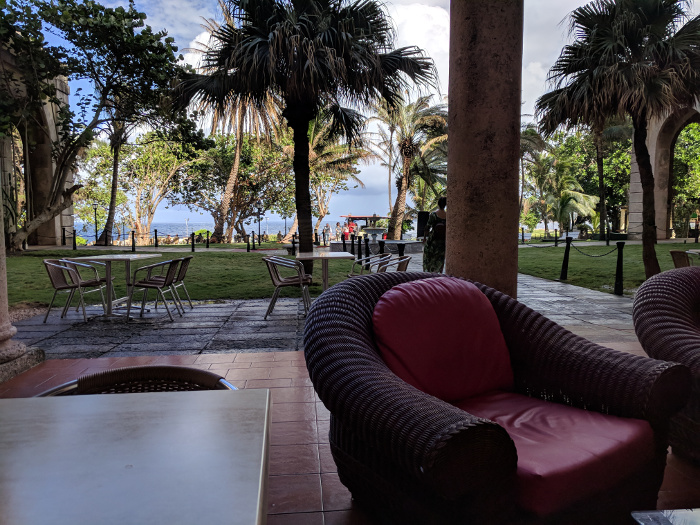
I ordered a Hotel Nacional Special and looked over to the bar to watch them make it.

While rain was once again threatening, it was otherwise a lovely day and I enjoyed relaxing with my drink.

I will say that I think I make them better, however. (grin)
We then wandered around the hotel a bit to soak in the atmosphere

and continuing in that vein we decided to take an “old car” taxi back to Old Havana.

Our driver was Pablo, and as he drove us back we passed some Havana landmarks such as the Great Theatre

and the Capitolio.

This building, which greatly resembles the US Capitol, was the seat of Cuban government before the revolution. It currently houses the National Library of Science and Technology, among other things, and is undergoing a restoration. Cubans like to say it is three feet taller, three feet longer and three feet wider than the US Capitol.
As we approached Old Havana I took one of my favorite pictures ever:

It is just such a nice composition of Pablo, the old purple car and the buildings in the background.
Our last evening event was held in a brewery. We sat at large tables with others from the conference, and I sat next to a woman named Inauri. I’m not sure how the discussion came up, but we ended up talking about race in Cuba.
One thing I noticed, outside of the lack of mobile phone zombies, was that there didn’t seem to be any real racial divides in Cuba. Cuba was such a focal point of trade in the New World that people from all over met, settled and had children in the country. There are blond-haired, blue-eyed Cubans as well as Cubans with skin so dark it is almost blue. Yet they seem to intermingle way more than in any other place I’ve been. Whether in a restaurant, a bar, walking down the street or in groups talking on street corners there was always this glorious mix of skin tone.
Inauri told me that before the revolution there were schools for rich “white” children, schools for poor white children and schools for everyone else. After the revolution it was declared that no matter your skin color, you were all Cubans, and while I’m sure it took some time it seems to have worked. I have no doubt that there are racists in Cuba but from my experience it was the first truly integrated culture I’ve seen.
The next morning we took another “classic” car to the airport. It was based on a 1953 Pontiac and was in incredible shape.

The driver was obviously proud of the condition of his car, and he even offered to turn on the air conditioning, which I don’t believe was stock in 1953.

It was a rainy morning and quite humid, so the A/C was nice. I took a few pictures on the ride, including this mural “Faithful to Our History”

and sat back reflecting on my visit.
I was extremely happy I went. The people in Cuba are amazing and I sincerely hope that the political situation both inside and outside the country warms up so that they can get access to the things they need to be great. I’m certain what they would create and share with the world would be wonderful.
